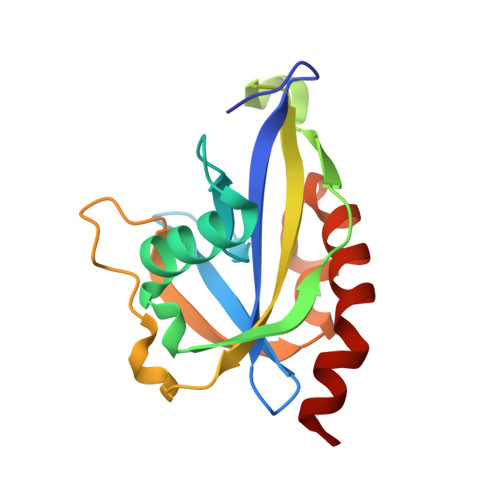A distinct RNA recognition mechanism governs Np 4 decapping by RppH.
Levenson-Palmer, R., Luciano, D.J., Vasilyev, N., Nuthanakanti, A., Serganov, A., Belasco, J.G.(2022) Proc Natl Acad Sci U S A 119
- PubMed: 35131855
- DOI: https://doi.org/10.1073/pnas.2117318119
- Primary Citation of Related Structures:
7SP3 - PubMed Abstract:
Dinucleoside tetraphosphates, often described as alarmones because their cellular concentration increases in response to stress, have recently been shown to function in bacteria as precursors to nucleoside tetraphosphate (Np 4 ) RNA caps. Removal of this cap is critical for initiating 5' end-dependent degradation of those RNAs, potentially affecting bacterial adaptability to stress; however, the predominant Np 4 decapping enzyme in proteobacteria, ApaH, is inactivated by the very conditions of disulfide stress that enable Np 4 -capped RNAs to accumulate to high levels. Here, we show that, in Escherichia coli cells experiencing such stress, the RNA pyrophosphohydrolase RppH assumes a leading role in decapping those transcripts, preferring them as substrates over their triphosphorylated and diphosphorylated counterparts. Unexpectedly, this enzyme recognizes Np 4 -capped 5' ends by a mechanism distinct from the one it uses to recognize other 5' termini, resulting in a one-nucleotide shift in substrate specificity. The unique manner in which capped substrates of this kind bind to the active site of RppH positions the δ-phosphate, rather than the β-phosphate, for hydrolytic attack, generating triphosphorylated RNA as the primary product of decapping. Consequently, a second RppH-catalyzed deprotection step is required to produce the monophosphorylated 5' terminus needed to stimulate rapid RNA decay. The unconventional manner in which RppH recognizes Np 4 -capped 5' ends and its differential impact on the rates at which such termini are deprotected as a prelude to RNA degradation could have major consequences for reprogramming gene expression during disulfide stress.
Organizational Affiliation:
Skirball Institute of Biomolecular Medicine, New York University School of Medicine, New York, NY 10016.


















